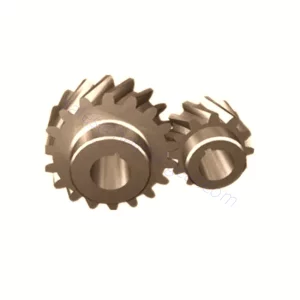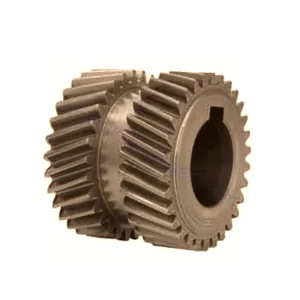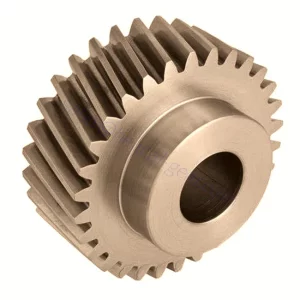Helical Gear
Crossed Helical Gear
Helical gears are quieter and operate more efficiently than spur gears. The teeth of a helical gear are cut at an angle to the gear face so that they gradually mesh as the gear rotates. The tangent to the helix angle varies in proportion to the thrust load. A helical gear is an excellent choice for high thrust because it produces far less friction and requires fewer bearings.
In addition to higher load capacity, helical gears are quieter and have less friction than spur gears. Since helical gears mesh in small increments, they are better suited for large loads and are also more efficient in high speed and high load applications. They are also a good choice for conveyor belts and elevators, and they can be used with parallel or non-parallel shafts.
As one of the leading helical gear manufacturers, suppliers, and exporters of mechanical products, We offer helical gear and many other products.Please get in touch with us for details.
Mail:[email protected]
There are two types of helical gears—parallel and crossed. Similar helical gears, the common one, is used for power transmission between parallel shafts. Two mating parallel helical gears should have the same module, same pressure angle but the opposite hand of the helix. They offer vibration-free and quiet operation and can transmit heavy loads. On the other hand, crossed helical gears are used for non-intersecting but vertical shafts. Two matings crossed helical gears (also called screw gears) should have the same module, same pressure angle, and either the same or opposite hand of the helix. This type of gear has applications similar to worm gear; however, the worm gear is preferred for steep speed reduction (1:15 to 1:100), whereas crossed helical gears cannot provide speed reduction beyond 1:2. Differences between parallel helical gear and struck helical gear are given below in table format.
Table: Differences between parallel helical gear and crossed helical gear
| Parallel Helical Gear | Crossed Helical Gear |
|---|---|
| Parallel helical gears can transmit motion and power between parallel shafts only. | Crossed helical gears can transmit motion and power between perpendicular but not-intersecting shafts. |
| Two mating gears must be mounted on two parallel shafts. | Two mating gears are mounted on two perpendicular but non-intersecting shafts. |
| Two mating gears should have the same helix angle but the opposite hand of the helix. | Two mating gears may have different helix angles. They may have either the same or opposite hand of the helix. |
| Engagement between two teeth starts with a point contact but gradually becomes a line contact. | Two meshing teeth always have point contact. |
| The power transmission capacity of parallel helical gear is higher due to broader contact. | Crossed helical gear has lower power transmission capacity due to point contact. |
| It has a vast application range from small equipment to large industrial fields, including gear trains. | It is rarely used in small-size instruments. |
Power transmission and orientation of shafts: Except for quarter-turn belts, the gear drive is the only mechanical drive that can be advantageously employed to transmit power and motion at any angle. Different types of gear are preferred for varying orientations of the driver and driven shafts. Similar to spur gears, parallel helical gears can only transmit motion and power between parallel shafts. Therefore they should be mounted on parallel poles with proper locational and angular alignment. On the other hand, crossed helical gears or screw gears can transmit motion and power between perpendicular shafts, and thus they should be mounted on perpendicular but non-intersecting shafts.
Hand of helix: Irrespective of parallel or cross arrangement, two mating helical gears should have the same module, same pressure angle, and same helix angle. The Pitch circle diameter of two mating gears should also touch at a single point. If the mating helical gears have a parallel arrangement, one gear should have the right-hand helix, and the other equipment should mandatorily have the left-hand helix. Thus, two mating similar helical gears must have an opposite hand of the helix. However, in a crossed arrangement, one helical gear with a right-hand helix can mate with another with either a left or right-hand helix. Thus, two matings crossed helical gears may have an identical or opposite hand of the helix.
Contact between teeth: Based on the teeth profile and gear orientation, contact between teeth of two mating gears occurs in several fashions. For example, the teeth of two spur gears come in sudden contact, and their contact length always remains a line of size equal to the teeth’ face width. Such sudden contact is replaced by gradual contact in helical gear. In the case of parallel helical gears, the mating of two teeth initiates with a point and gradually becomes a line, and then they disengage as a point. However, in the case of crossed helical gears, contact between two teeth always remains a single point. At the beginning of the engagement, this point lies at one end of the teeth face, and gradually the contact point moves over the face. At disengagement, the contact point lies on the other end of the teeth face.
Power transmission capacity: The primary purpose of every mechanical drive is to transmit power from the driving shaft to the driven shaft. Being an engagement-type rigid drive, the gear drive has the maximum transmission capacity among all mechanical movements. However, different types of gear drives offer varying levels of power transmission capacity. A pair of parallel helical gears can transmit comparatively higher power than similar size spur gear of the same material. Parallel helical gears can share from only a few watts to a few mega-watt power based on the size and material. On the other hand, crossed helical gears are preferred for small power transmission, usually limited to 100kW.
Areas of application: Parallel helical gears are advantageous due to their high power transmission capacity. It can be successfully employed for low-speed as well as high-speed applications. Typical application areas include gearbox of machines, automobiles, oil mills, marine drive, etc. On the other hand, crossed helical gears are suitable for low-speed and low-duty applications such as roving machines in the textile industry, oil pumps for internal combustion engines, etc.




